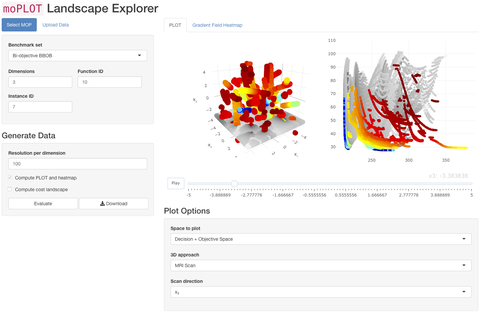Sep 21, 2021
Peeking Beyond Peaks: A Publication on the Implications of Multimodality in Multiobjective Optimization
Multi-objective optimization, i.e., the simultaneous optimization of multiple conflicting objectives (travel time vs. transportation costs, spatial comfort vs. maximum capacity within a vehicle, solution quality vs. computational efforts, etc.), is gaining more and more attention in various research areas, such as evolutionary computation, machine learning (e.g., (hyper-)parameter optimization), or logistics (e.g., vehicle routing). Many works in this domain mention the structural problem property of multimodality as a challenge from two classical perspectives: (1) finding all globally optimal solution sets, and (2) avoiding to get trapped in local optima. Interestingly, these streams seem to transfer many traditional concepts of single-objective optimization into claims, assumptions, or even terminology regarding the multi-objective domain, but mostly neglect the understanding of the structural properties as well as the algorithmic search behavior on a problem’s landscape. That is, multi-objective optimization is mainly still treated as a black-box -- usually due to a scarcity of visualization techniques, which could help researchers to better understand the actual characteristics and obstacles of multi-objective problems. However, some recent works counteract this trend, by investigating the fundamentals and characteristics of multi-objective problems using new visualization techniques and gaining surprising insights.
Picking up on these visual insights, our work presents a unified terminology for properties such as multimodality and locality within this work and thereby enables an investigation of current research activities in multimodal continuous multi-objective optimization. Moreover, we highlight new implications and promising research directions for the design of benchmark suites (which are needed to study such problems and develop efficient optimization algorithms), the discovery of multi-objective landscape features (needed to characterize the problems), as well as the development of new multi-objective (or even single-objective) optimization algorithms, and performance indicators. For all these topics, we provide a review of ideas and methods but also an outlook on future challenges, research potential and perspectives that result from recent developments.
This work results from an international collaboration of researchers from TU Dresden, University of Münster, University of Leiden (Netherlands), University of Twente (Netherlands), and Sorbonne Université (France).
Multiple authors of this work have been participants of the internationally renowned Dagstuhl Seminar on "Scalability in Multiobjective Optimization" and in consequence this manuscript has been published as part of a Special Issue on "Modern Trends in Multiobjective Optimization" within the Computers and Operations Research Journal.
The full article can be accessed using the following link: https://authors.elsevier.com/a/1dXSv15N8SFYn-

